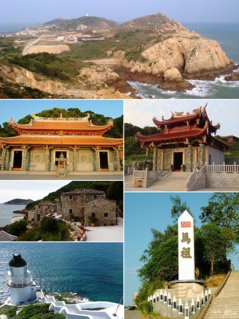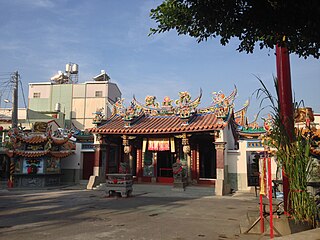
Taiwan, officially known as the Republic of China (ROC), is divided into multi-layered statutory subdivisions. Due to the complex political status of Taiwan, there is a significant difference in the de jure system set out in the original constitution and the de facto system in use today.

The Matsu Islands are an archipelago of 36 islands and islets in the East China Sea officially named Lienchiang County in the Republic of China. It is the smallest county of Taiwan Area.

A city, previously provincial city, is an administrative division unit in Taiwan.

Linbian Township is a rural township in western Pingtung County, Taiwan. It lies at the mouth of the Linbian River, facing the Taiwan Strait. It is known for its year-round warm climate, seafood restaurants and its wax apples (lembus).

When referring to political divisions of China, town is the standard English translation of the Chinese 镇. The Constitution of the People’s Republic of China currently classifies towns as third-level administrative units, along with townships and ethnic minority townships. A township is typically smaller in population and more remote than a town (zhèn).

Jiaoxi Township or Chiaohsi Township is a rural township in the northern section of Yilan County, Taiwan.

The Free area of the Republic of China is a term used by the government of the Republic of China (ROC) to refer to the territories under its actual control. The area under the definition consists of the island groups of Taiwan, Penghu, Kinmen, Matsu and some minor islands. This term is used in the "Additional Articles of the Constitution of the Republic of China". As the island of Taiwan is the main component of the whole area, it is also referred to as the "Taiwan Area of the Republic of China" or simply the "Taiwan Area". The term "Tai-Peng-Kin-Ma" is also essentially equivalent except that it only refers to the islands of Taiwan, Penghu, Kinmen and Matsu Area, to the exclusion of the South China Sea possessions-Dongsha Islands and Taiping Island.

Fuding (help·info) is a county-level city in northeastern Ningde prefecture level city, on Fujian's border with Zhejiang province.

Fengbin Township is a rural township located in Hualien County, Taiwan, bordering Taitung County. The Pacific Ocean lies to the east and the Hai'an Range to the west.

Qionglin Township is a rural township in central Hsinchu County, Taiwan. Its population was estimated at 20,158 in January 2017.

Zhutian Township, also spelled Jhutian, is a rural township in Pingtung County, Taiwan.

Xinpi Township, also spelled Sinpi, is a rural township in Pingtung County, Taiwan.

Sandimen Township is a mountain indigenous township in Pingtung County, Taiwan. The population of the township consists mainly of the Paiwan people with a substantial Rukai minority.

Jiuru Township is a rural township in Pingtung County, Taiwan.

Jinsha Township (Kinsha) is an urban township in the north-eastern corner of Greater Kinmen Island (Quemoy), Kinmen County, Fujian Province, Republic of China (Taiwan). It is in the Taiwan Strait, on the coast of mainland China.

Jinhu Township is an urban township of Kinmen, Fujian Province, Republic of China (Taiwan). It is in the Taiwan Strait, on the coast of mainland China. Jinhu Township is the largest township in Kinmen County.
Districts are administrative subdivisions of special municipalities and provincial cities of Taiwan. There are two types of district in the administrative scheme.

A county, constitutionally known as a hsien, is an administrative division unit in Taiwan. Under the administrative structure of Taiwan, it is with the same level of a provincial city. Historically the counties were under the jurisdiction of provinces, but after the streamlining of provinces in 1998, they are all directly led by the central government.

A special municipality is an administrative division unit in the Republic of China (Taiwan). Under the administrative structure of the ROC, it is the highest rank of division and is equivalent to a province. Since the streamlining of provinces in 1998, the special municipalities along with provincial cities and counties have all been directly under the central government. Currently there are six special municipalities in Taiwan: Kaohsiung, New Taipei, Taichung, Tainan, Taipei and Taoyuan.
Villages are the basic level administrative subdivisions of Taiwan, under townships, county-administered cities or districts. There are two types of villages depending on the divisions it belongs to.


















